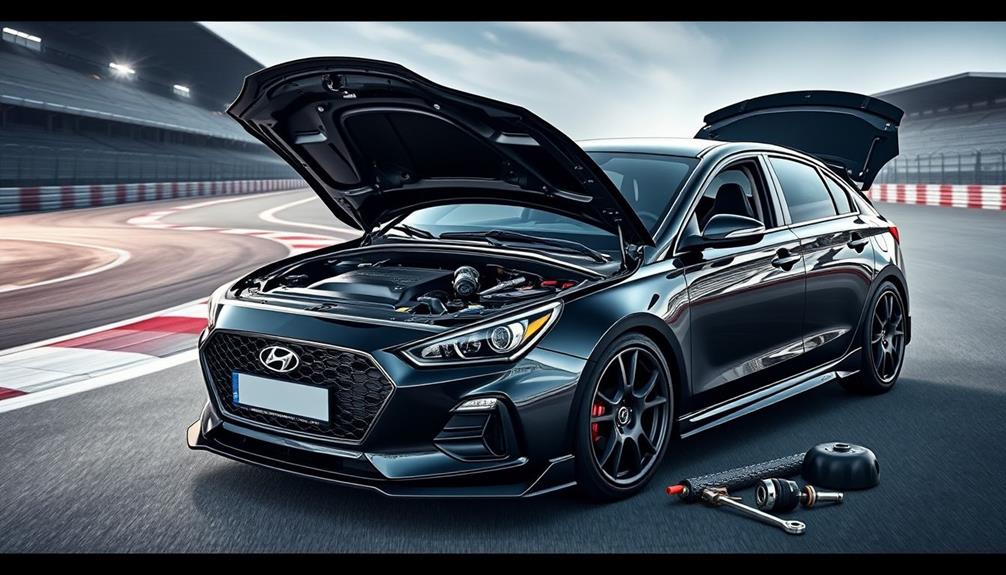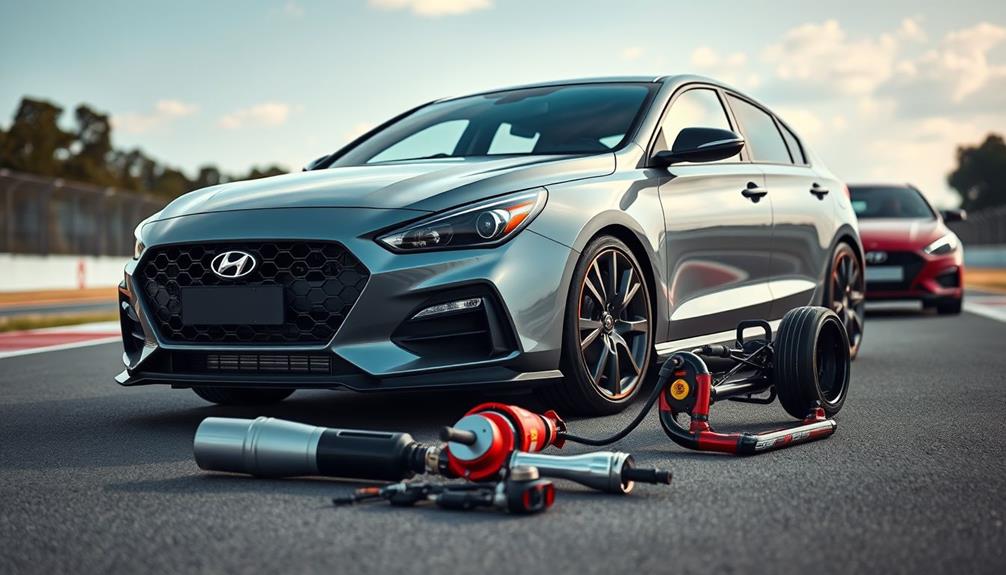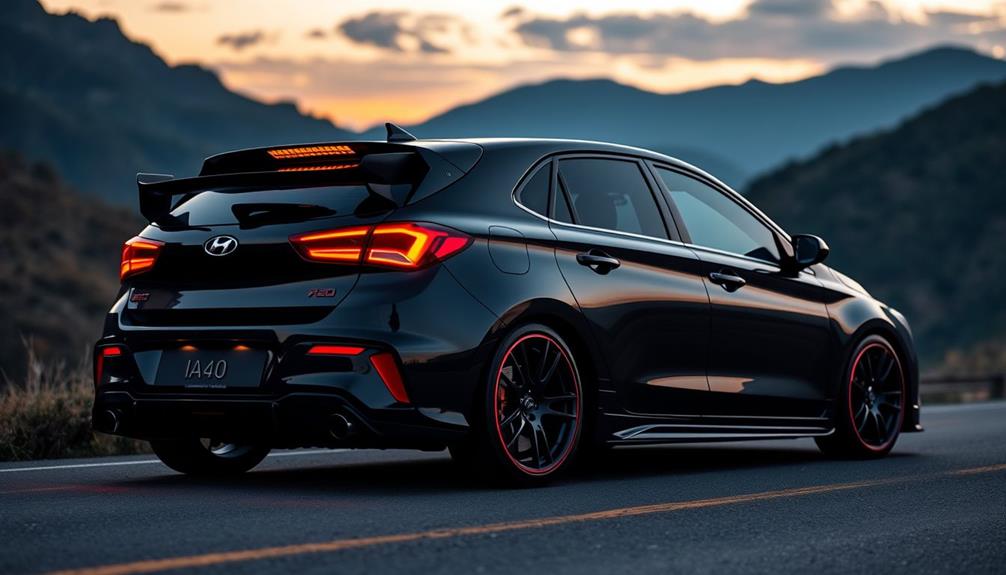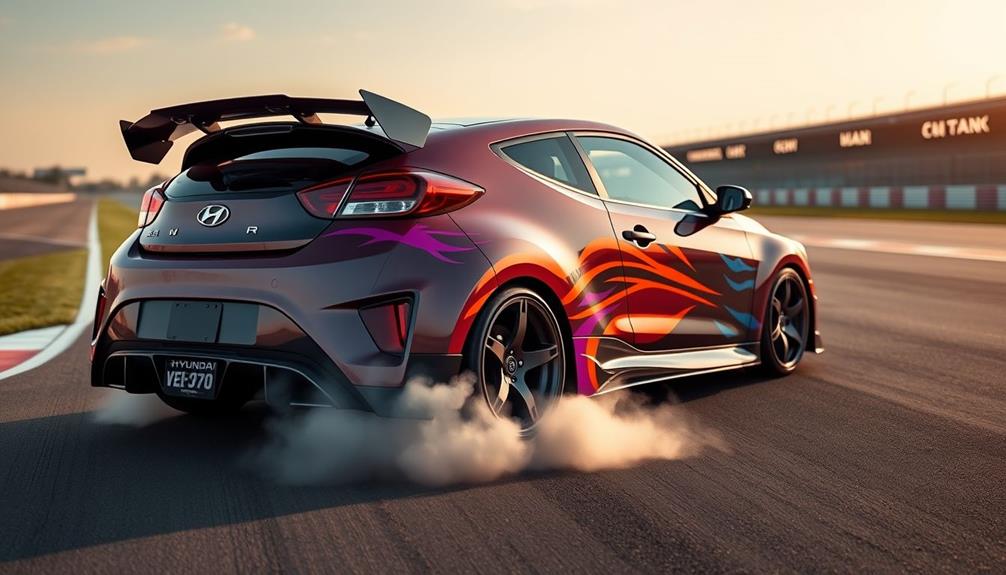Tuning your Hyundai I40 is a fantastic way to turn it into a performance beast without sacrificing family-friendly features. Start with simple upgrades, like a sports exhaust and ECU remapping, to boost horsepower and improve engine efficiency. As you progress, consider advanced modifications such as high-flow fuel injectors and suspension upgrades for better handling. Braking enhancements will guarantee you stay safe while enjoying your newfound power. You can even engage with fellow enthusiasts for tips and advice. There's a lot to explore, and soon enough, you'll be releasing the full potential of your I40.
Key Takeaways
- Upgrade components like sports exhaust and high-performance air intake systems to enhance airflow and engine efficiency for better performance.
- Consider ECU remapping to optimize power delivery and improve overall drivability after modifications.
- Implement handling upgrades such as suspension drops and polyurethane bushings for enhanced stability and responsiveness during dynamic driving.
- Explore forced induction options, like turbochargers, for substantial power gains, but be aware of the complexity and costs involved.
- Engage with Hyundai i40 tuning communities for insights, support, and shared experiences on effective performance upgrades.
Tuning Modifications for Hyundai I40
When it comes to tuning your Hyundai i40, there are several key modifications that can dramatically enhance its performance. For recent models, you'll want to start with brake upgrades to improve stopping power, ensuring your car can handle its newfound speed.
Upgrading the fuel pump is also vital, especially if you're planning on more extensive tuning.
Next, consider installing a sports exhaust and a high-performance air induction system. These changes can considerably boost your engine's airflow and power potential.
If you're eyeing a Stage 1 tune, don't forget to remap your ECU for optimized performance. Dropping the suspension by 25-39mm will improve handling, while lighter alloy wheels can enhance acceleration.
If you have a turbocharged variant, remapping and forced induction enhancements can lead to impressive power gains.
As you push your i40's limits, upgrading to a power or sport clutch becomes essential to prevent slippage and maintain performance integrity.
I40 Tuning Stages

When tuning your Hyundai i40, understanding the different stages is essential.
Stage 1 mods offer simple upgrades for noticeable gains, while Stage 2 brings in performance enhancements that push your engine further.
If you're looking for serious power, Stage 3 advanced upgrades will maximize your i40's potential with sophisticated modifications.
Stage 1 Modifications Overview
Starting with Stage 1 modifications for your Hyundai i40 can greatly enhance its performance and driving experience. If you're looking to transform your large family car into a performance beast, consider these key upgrades:
- Sports Exhaust – This modification not only sounds great but also improves airflow, boosting engine efficiency.
- Alloy Wheels – Lighter than stock, they reduce unsprung weight, enhancing acceleration and handling.
- Suspension Drop (25-39mm) – Lowering your i40 improves stability and reduces body roll during cornering, making every drive sportier.
- ECU Remap – Release additional horsepower, especially for turbocharged models, potentially adding 40-60 HP by optimizing the air-fuel mixture.
Additionally, upgrading to a lighter flywheel enhances throttle response, giving you quicker acceleration.
To guarantee your newly tuned engine delivers consistent power, installing a sports clutch is advisable to prevent slippage.
These modifications won't only improve performance but also elevate your driving pleasure, making it an exciting choice for a large family car.
With these changes, your Hyundai i40 becomes more than just a family vehicle; it's a thrilling ride you'll love to drive!
Stage 2 Performance Enhancements
After laying the groundwork with Stage 1 modifications, it's time to elevate your Hyundai i40's performance even further with Stage 2 enhancements. In this stage, you'll want to install a power/sport clutch and a fast road cam. These upgrades greatly improve power delivery and acceleration, making your driving experience much more exhilarating.
To support the added power, upgrading to high-flow fuel injectors and an upgraded fuel pump is essential. This guarantees your engine receives adequate fueling for the increased performance levels.
Additionally, consider ported head work, which involves professional flow optimization and installing larger valves. This modification enhances airflow and overall engine performance, particularly beneficial for turbocharged variants of the i40.
However, simply adding these components isn't enough. You'll need to carefully remap your engine control unit (ECU) to optimize performance and maintain drivability. This remapping guarantees all your enhancements work in harmony, providing you with a considerable boost in horsepower and torque.
With these Stage 2 performance enhancements, your Hyundai i40 will truly become a performance beast on the road. Get ready to enjoy the thrill of driving like never before!
Stage 3 Advanced Upgrades
As you immerse yourself in Stage 3 upgrades for your Hyundai i40, you'll access a new level of performance that takes your driving experience to exhilarating heights.
These advanced modifications transform your family car into a powerful beast, ready to tackle any challenge on the road.
Here's what you can expect with Stage 3 upgrades:
- Engine Balancing: This enhancement boosts your engine's stability and performance under high power conditions, ensuring smooth operation.
- Sports Gearbox: Experience quicker shifts and improved power delivery to the wheels, enhancing your driving dynamics.
- Internal Engine Upgrades: Incorporating forged pistons and rods, these components are essential for handling increased power levels while ensuring durability.
- Forced Induction Enhancements: Upgrading your turbocharger or supercharger can greatly enhance power output, providing thrilling performance gains.
With the addition of a competition camshaft, you'll optimize airflow and responsiveness at higher RPMs, making your i40 a true powerhouse.
Stage 3 upgrades will elevate your driving experience, transforming your everyday ride into an exhilarating performance machine.
Get ready to release the full potential of your Hyundai i40!
Handling and Suspension Upgrades

If you're looking to enhance your Hyundai i40's handling, consider a suspension drop of 25-39mm for better stability without sacrificing too much comfort.
Upgrading to stiffer polyurethane bushings can also boost responsiveness, although you might notice a firmer ride.
These adjustments work together to greatly improve your cornering performance and overall driving dynamics.
Suspension Drop Recommendations
A suspension drop of 25-39mm can greatly enhance your Hyundai i40's handling and stability while still keeping ride comfort in check.
By lowering your vehicle, you'll reduce body roll and achieve better cornering capabilities. This modification makes your car feel more responsive, especially during aggressive driving.
Here are some key recommendations for optimizing your suspension drop:
- Choose Stiffer Dampers or Coilovers: These will maintain control and improve overall handling performance after the drop.
- Check Compatibility: Different models may present compatibility issues, so always verify your specific vehicle requirements before making changes.
- Adjust Toe and Camber Settings: Post-drop adjustments can notably enhance cornering dynamics and overall grip on the road.
- Consider a Professional Alignment: This guarantees your suspension modifications yield the best performance and longevity.
Implementing these recommendations can transform your i40 into a more thrilling ride without sacrificing practicality.
Enjoy the drive, and make the most of your family car's newfound performance!
Benefits of Polyurethane Bushes
Upgrading to polyurethane bushes can greatly enhance your Hyundai i40's handling and suspension performance. These bushes are stiffer than traditional rubber options, giving you improved handling and responsiveness during cornering and dynamic driving situations.
You'll notice a significant difference in how your vehicle reacts, especially when pushing it to its limits.
Another advantage is their enhanced durability and longevity. Polyurethane bushes often outlast rubber alternatives by several years, meaning you won't need to replace them as frequently.
This longevity contributes to a more stable and confident driving experience, minimizing body roll, and making your i40 feel more composed on the road.
While it's true that these bushes can transmit more road noise and vibrations into the cabin, the payoff is sharper steering feedback and a more connected feel to the road.
This connection can elevate your driving experience, making it more engaging and enjoyable.
Additionally, you can find custom polyurethane bush options tailored to your specific driving style and vehicle setup.
This means you can fine-tune your i40's handling characteristics to match your personal preferences, giving you the ultimate driving experience.
Intake and Exhaust Tuning

Enhancing your Hyundai i40's performance begins with tuning the intake and exhaust systems. By upgrading these components, you can greatly improve airflow and overall engine performance, especially when paired with a remap.
Here are four key steps to keep in mind:
- Upgrade to High-Performance Air Intake Systems: These systems allow for better airflow, increasing your engine's efficiency and power output.
- Choose a Properly Sized Sports Exhaust: An exhaust that's too large can hinder exhaust flow, reducing your power gains. Aim for a balance that maximizes performance.
- Replace Standard Air Intakes: Standard options limit your performance potential. Upgrading is vital for achieving higher power levels and enhancing throttle response.
- Adjust Fueling Components: After modifying the intake and exhaust, it's essential to upgrade fuel injectors and pumps to handle the increased airflow and maintain peak performance.
Forced Induction Insights

After fine-tuning your intake and exhaust systems, you might consider taking performance to the next level with forced induction. Turbocharged engines can deliver exponential power gains, especially as engine speed increases, making them a fantastic choice for serious enhancements.
However, adding a turbocharger typically means you'll need to modify the engine's compression ratio or incorporate water injection to guarantee reliability.
On the other hand, superchargers provide a more linear boost in power that's directly proportional to engine speed. This can simplify the tuning and mapping process, making it easier for you to achieve the desired performance.
Keep in mind that installing a turbocharger is often more complex than a supercharger setup, requiring additional components and precise adjustments.
While the thrill of increased power is enticing, don't forget about the high costs associated with forced induction systems. They may limit the cost-effectiveness of your upgrades, so careful planning and budgeting are essential.
Ultimately, whether you choose a turbocharger or supercharger, forced induction can transform your Hyundai i40 into a true performance beast if approached thoughtfully.
Community Engagement and Resources

Joining forums dedicated to Hyundai i40 tuning can really enhance your experience as an owner.
You'll find a community enthusiastic to share knowledge, answer your questions, and provide insights on the best performance upgrades.
Engaging with fellow enthusiasts not only helps you learn but also keeps you updated on the latest trends in tuning.
Forum Participation Encouraged
Participating in forums can greatly enrich your experience as a Hyundai i40 owner. Engaging in discussions allows you to connect with fellow enthusiasts, share tuning experiences, and gather valuable insights.
It's a fantastic way to build a supportive community atmosphere where everyone benefits.
Here are some reasons why you should immerse yourself in forum participation:
- Share Experiences: Exchange tuning tips and advice with other i40 owners who've been down the same road.
- Ask Questions: Post specific tuning queries and get feedback from seasoned tuners who've successfully modified their vehicles.
- Refine Knowledge: Help improve tuning articles and guides by providing your feedback, ensuring that the content is accurate and relevant.
- Network with Enthusiasts: Engage with like-minded individuals, enhancing your knowledge and fostering camaraderie among i40 owners.
Knowledge Sharing Community
Engaging with a knowledge-sharing community centered around Hyundai i40 tuning can considerably enhance your experience and understanding of vehicle modifications. By participating in dedicated forums, you'll find a collaborative learning environment where fellow enthusiasts share insights, tips, and personal experiences.
This exchange of information is invaluable, as user feedback helps refine tuning articles and guides, ensuring they stay accurate and relevant. Community discussions provide a platform for you to ask questions and receive advice on various tuning modifications.
Whether you're a beginner or an experienced tuner, tapping into this collective knowledge will boost your overall expertise. You'll also discover that participation can lead to networking opportunities, connecting you with other i40 owners who share your passion.
This expanded network amplifies your resource pool for tuning advice and support. Moreover, you'll have access to extensive tuning guides and articles on different Hyundai models, offering a treasure trove of valuable information.
Engaging in this knowledge-sharing community not only enhances your tuning journey but also fosters lasting friendships with like-minded enthusiasts. So immerse yourself, ask questions, and most importantly, enjoy the ride!
ECU Chip Recommendations

When you're looking to enhance the performance of your Hyundai i40, choosing the right ECU chip can make a significant difference. A quality ECU chip can boost your horsepower by 40-60 and improve fuel efficiency by up to 5 MPG.
Here are some recommendations to guide your choice:
- Brand Reputation: Go for reputable brands known for quality and performance gains. Research user experiences and community recommendations to gauge reliability.
- Performance Reviews: Look for chips with strong user feedback. Reviews often reveal insights into real-world performance improvements and potential issues.
- Cost vs. Gains: Weigh the cost of the ECU chip against the expected performance enhancements. Verify your investment aligns with your performance goals.
- Installation Support: Choose a chip that offers good customer support and installation guidance to guarantee a smooth upgrade process.
With these considerations in mind, you'll be on your way to transforming your Hyundai i40 into a performance beast.
Just remember, tuning could affect your manufacturer warranty, so keep that in mind as you make your decision.
Warranty Considerations

Tuning your Hyundai i40 can greatly enhance its performance, but it's important to reflect on how these modifications might impact your warranty. Many tuning modifications can void your manufacturer's warranty, which means you'll need to take on the responsibility for any issues that arise post-tuning.
Under the Magnuson-Moss Warranty Act, manufacturers have to prove that your modifications directly caused any engine failure to deny your warranty claims. However, legal disputes can emerge if your claims are rejected, so it's crucial to understand your warranty rights before diving into modifications.
You should also weigh the potential costs associated with engine failures against the performance benefits you hope to gain. Keeping detailed records of all tuning modifications is significant; this documentation can support any future warranty claims or disputes.
Before proceeding, consider discussing your plans with your dealer or a tuning expert. They can help clarify what modifications might be safe while keeping your warranty intact.
Ultimately, being informed about how tuning affects your warranty can save you from unexpected expenses and headaches down the road.
Performance Vs. Fuel Economy

Balancing performance and fuel economy can feel like walking a tightrope, especially when considering modifications for your Hyundai i40. Achieving increased performance often comes at the cost of fuel economy, but modern engines are surprisingly adept at marrying both aspects.
Many users report that tuning their i40 enhances power without drastically sacrificing mileage.
When tuning your vehicle, keep these points in mind:
- Power Gains: Expect noticeable increases in horsepower, making your drives more exhilarating.
- Fuel Consumption: Be aware that some modifications may lead to higher fuel consumption rates.
- Real-World Mileage: Users often find their mileage satisfactory even post-tuning, thanks to the efficient design of current models.
- Adjust Expectations: It's crucial to align your performance expectations with observed data; discrepancies between mileage and power output are common.
Ultimately, while you can enhance your i40's performance, you'll need to embrace a slight shift in fuel economy.
With the right balance, you can enjoy a thrilling driving experience without compromising too much on efficiency.
Engine Durability Concerns

The durability of your Hyundai i40's engine can become a significant concern after tuning. While tuning can enhance performance, it often comes at the cost of increased stress on engine components. Many users have reported issues with engine reliability post-tuning, suggesting that the benefits of added horsepower and torque may not outweigh the potential risks.
You should also be aware that tuning can lead to discrepancies in mileage readouts. This can complicate your understanding of how well your engine is performing and may mask underlying problems.
To protect your engine's longevity, regular maintenance and monitoring after tuning are vital. Keeping a close eye on oil levels, coolant, and overall engine health can help you catch issues before they escalate.
Ultimately, as a tuner, it's important to weigh the performance improvements against the possibility of engine failure. Overstressing your engine components can lead to costly repairs and reduced lifespan.
Frequently Asked Questions
Can You Remap a Hyundai I40?
Yes, you can remap a Hyundai i40. By adjusting the ECU, you'll enhance its performance, gaining extra horsepower and torque. Just guarantee you've got the necessary supporting modifications to handle the increased power effectively.
Why Was the Hyundai I40 Discontinued?
The Hyundai i40 was discontinued due to declining sales and shifting consumer preferences towards SUVs. You'll find that compact sedans like the i40 struggled to compete with more versatile and popular vehicle options in today's market.
Is the Hyundai I40 a Good Car?
Yes, the Hyundai i40's spacious interior, efficient engines, and advanced safety features make it a great family car. You'll appreciate its comfort on long journeys, plus its reliability and positive reviews for fuel efficiency.
What Is the GDI Engine of the Hyundai I40?
While other engines struggle with efficiency, the GDI engine in your Hyundai i40 excels. It injects fuel directly for better performance and reduced emissions, giving you a thrilling driving experience without compromising on eco-friendliness.
Conclusion
Tuning your Hyundai i40 can truly transform it into a performance beast, enhancing both power and handling. Did you know that a well-tuned car can improve its horsepower by up to 30%? With the right modifications, you'll not only enjoy a more thrilling drive but also maintain a balance between performance and fuel economy. Just keep in mind the potential impacts on your warranty and engine durability. So, are you ready to release your i40's true potential? By exploring powerful tuning options such as ECU remapping, exhaust system upgrades, and intake modifications, you can unlock even more potential in your Hyundai i40. These enhancements can take your driving experience to a whole new level, giving you a car that is both powerful and efficient. Just be sure to do your research and work with a reputable tuning specialist to ensure that the modifications are done safely and effectively. Unlock the true potential of your Hyundai i40 with the right tuning upgrades.










